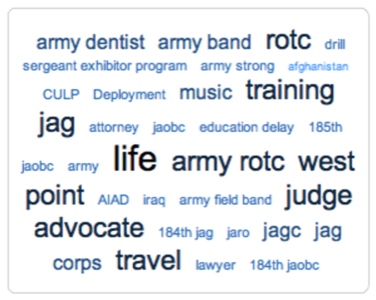One of the most interesting aspects of Web technology and social media nowadays is how it’s being deployed by non-techies. Recently I had the chance to connect with the U.S. Army to find out how it is using the Web. Blogging, Twitter, Facebook, online video and more is currently in operation at U.S. Army HQ.

I spoke to Suzanne Nagel, Digital Chief, U.S. Army Accessions Command, who walked me through how the Web is being used for recruitment and community. We started off by discussing a blog called Army Strong Stories, which enables people to hear authentic stories from U.S. Army soldiers.
Launched in 2008, the target audience of Army Strong Stories is the U.S. Army’s primary recruiting target: men aged 18-24. This age group spends a lot of time online, so a blog was seen as an effective way to reach that audience. The site also reaches women in the same age group, but Nagel explained that about 80% of jobs in the U.S. Army aren’t open to women (I didn’t realize it was that high a number).
Real Army Stories
The idea behind Army Strong Stories is to interact with the target audience and enable them to read and hear stories about Army life. Soldiers are encouraged to engage with the readers by replying to comments. The aim is to build a dialog with potential recruits, partly to disavow them of myths about Army life – for example, said Nagel, the scream-in-your-face drill sergeant so often portrayed in Hollywood movies.

Army Strong Stories features blog posts about anything related to army life. It’s not necessarily career based content (see the tag cloud to the right for a list of topics). I asked Suzanne Nagel whether the bloggers write about politics. She replied that generally no, however the Army doesn’t censor or filter content – other than for bad language.
Video is a relatively new part of the site, generally featuring Army staff speaking for a couple of minutes about their lives.
I’ve Traveled the World as a Saxophone Player; by Staff Sergeant Daniel Post
Army Strong Stories isn’t the Army’s main Web presence. Goarmy.com is the main recruiting website, which is used for recruiting soldiers and presenting facts about the Army.
Usage so far of Army Strong Stories has been broad, said Nagel. She noted that it’s not just men 18-24 who frequent the site. Regulars include bloggers’ parents and other relatives.
Army Social Media
Of course, in this day and age, it isn’t all about the blog. The Army uses Facebook and Twitter a lot. It also has both an iPhone app and a mobile website, featuring the same functionality as the website. They are currently working on an iPad version and will “probably” work on an Android version in the future.
Overall, the U.S. Army is actively growing its digital efforts. In particular, and in common with many other organizations, over the past 5 years it has increasingly used social media.

The Army is working on building up its social networking presence even further: for example, buying online advertising to drive users to its Facebook Page. Also, the Army will be doing “social media events” this year, in order to drive traffic and buzz to their sites. What form these events will take hasn’t been decided yet.
The goal of all the U.S. Army’s sites – whether self-hosted blogs or social networks like Facebook and Twitter – is to “keep the conversation flowing.”
Uncle Sam Needs You, See Our Facebook Page For More…
In general, the U.S. Army is a conservative branch of the military, remarked Suzanne Nagel, so allowing soldiers to tell their “mostly unfiltered stories” was a big step for them.
The hope is that the Army’s online and social media presence will help recruiting, by showing what real Army life is like and helping people overcome the fear of joining.
I was impressed by the sophistication of the U.S. Army’s web presence, although it helps that it’s likely very well funded. What do you think of the U.S. Army’s online activities? A good use for your taxpayer dollars?










